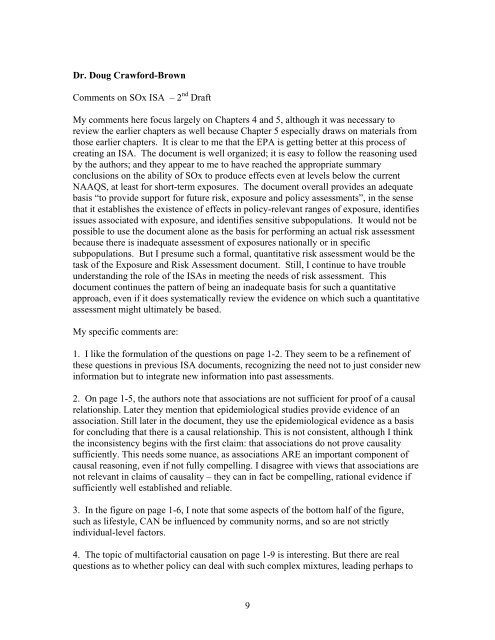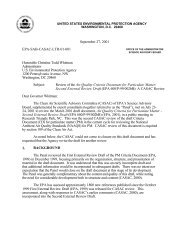(CASAC) Peer Review of EPA's Integrated Science Assessment
(CASAC) Peer Review of EPA's Integrated Science Assessment
(CASAC) Peer Review of EPA's Integrated Science Assessment
You also want an ePaper? Increase the reach of your titles
YUMPU automatically turns print PDFs into web optimized ePapers that Google loves.
Dr. Doug Crawford-BrownComments on SOx ISA – 2 nd DraftMy comments here focus largely on Chapters 4 and 5, although it was necessary toreview the earlier chapters as well because Chapter 5 especially draws on materials fromthose earlier chapters. It is clear to me that the EPA is getting better at this process <strong>of</strong>creating an ISA. The document is well organized; it is easy to follow the reasoning usedby the authors; and they appear to me to have reached the appropriate summaryconclusions on the ability <strong>of</strong> SOx to produce effects even at levels below the currentNAAQS, at least for short-term exposures. The document overall provides an adequatebasis “to provide support for future risk, exposure and policy assessments”, in the sensethat it establishes the existence <strong>of</strong> effects in policy-relevant ranges <strong>of</strong> exposure, identifiesissues associated with exposure, and identifies sensitive subpopulations. It would not bepossible to use the document alone as the basis for performing an actual risk assessmentbecause there is inadequate assessment <strong>of</strong> exposures nationally or in specificsubpopulations. But I presume such a formal, quantitative risk assessment would be thetask <strong>of</strong> the Exposure and Risk <strong>Assessment</strong> document. Still, I continue to have troubleunderstanding the role <strong>of</strong> the ISAs in meeting the needs <strong>of</strong> risk assessment. Thisdocument continues the pattern <strong>of</strong> being an inadequate basis for such a quantitativeapproach, even if it does systematically review the evidence on which such a quantitativeassessment might ultimately be based.My specific comments are:1. I like the formulation <strong>of</strong> the questions on page 1-2. They seem to be a refinement <strong>of</strong>these questions in previous ISA documents, recognizing the need not to just consider newinformation but to integrate new information into past assessments.2. On page 1-5, the authors note that associations are not sufficient for pro<strong>of</strong> <strong>of</strong> a causalrelationship. Later they mention that epidemiological studies provide evidence <strong>of</strong> anassociation. Still later in the document, they use the epidemiological evidence as a basisfor concluding that there is a causal relationship. This is not consistent, although I thinkthe inconsistency begins with the first claim: that associations do not prove causalitysufficiently. This needs some nuance, as associations ARE an important component <strong>of</strong>causal reasoning, even if not fully compelling. I disagree with views that associations arenot relevant in claims <strong>of</strong> causality – they can in fact be compelling, rational evidence ifsufficiently well established and reliable.3. In the figure on page 1-6, I note that some aspects <strong>of</strong> the bottom half <strong>of</strong> the figure,such as lifestyle, CAN be influenced by community norms, and so are not strictlyindividual-level factors.4. The topic <strong>of</strong> multifactorial causation on page 1-9 is interesting. But there are realquestions as to whether policy can deal with such complex mixtures, leading perhaps to9
















